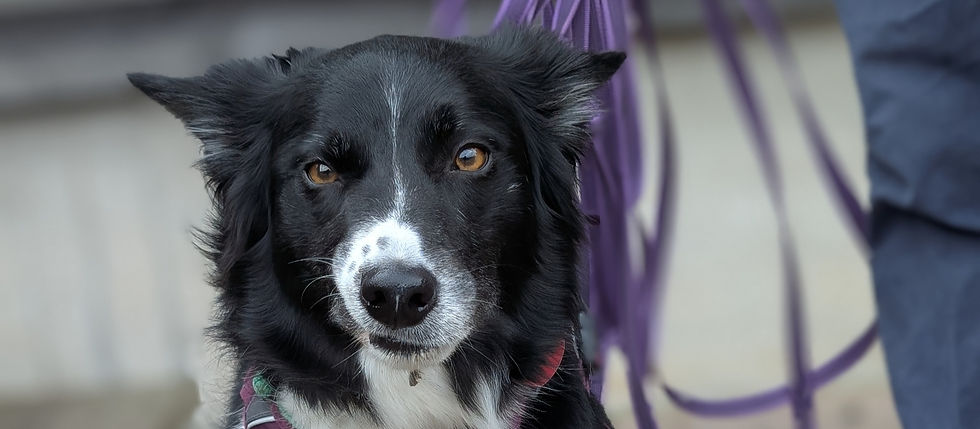One Language, Many Voices: How to Get the Most From Your Training
- Aug 13
- 4 min read
I’m a big believer in the value of training with more than one instructor. Different people bring different strengths such as new perspectives, fresh challenges, and opportunities you might not get if you always train in the same place with the same person. Variety can keep both you and your dog motivated, engaged, and progressing.
From working with hundreds of mantrailing teams (and backed by solid research), I’ve found that this variety works best when the training method stays consistent. That way, you get all the benefits of fresh input without your dog having to relearn the basics each time.
It’s not about loyalty to one instructor, far from it. It’s about giving your dog the clarity they need to succeed, so they’re never left wondering, “Wait… what game are we playing today?”

The Value of Learning from Multiple Voices
Working with different instructors can be an excellent way to keep training fresh and continue developing both your skills and your dog’s abilities.
Fresh perspectives - one instructor might be brilliant at reading your dog’s micro-signals, while another spots something in your handling you’d never noticed.
New challenges - a different environment, a different way of explaining things, or a new training location can push you (and your dog) to adapt.
Real-world prep - your dog learns to work with different people and voices, which helps them be more adaptable and confident in unfamiliar settings.
It’s the same reason sports teams often have more than one coach, because they each bring different strengths, but the playbook stays the same.

Where It Gets Tricky: The Method Matters
Here’s where science steps in. Dogs learn through:
Classical conditioning — forming associations between a cue or context and a particular outcome (Pavlov, 1927).
Operant conditioning — learning which actions lead to rewards or consequences, a concept famously explored and defined by B.F. Skinner (Skinner, 1938).
When the “rules of the game” are consistent; same cues, same reward style, same start type, the brain builds stronger and faster neural connections. Change those rules too often, and you risk weakening the existing learning.
Research by Bouton (2000) on extinction shows that when a learned behaviour is no longer reinforced in the way the learner expects, it doesn’t disappear, it becomes inhibited. That behaviour can resurface if the context changes or the old reinforcement pattern returns (known as “renewal” or “spontaneous recovery”). In training terms, altering the method too often can create a constant state of “starting over,” where the dog’s previous understanding gets buried under conflicting information.
In sports like mantrailing, this is especially important. Studies show dogs don’t just remember the smell, they remember how the task was set up (Hall et al., 2015). Change the setup too much, and the dog may not connect today’s trail to what they learned last week.
Variety Without Confusion
Mix up your instructors, keep your method consistent.
This approach allows you to benefit from fresh ideas, new environments, and different teaching styles, while maintaining a clear and predictable framework for your dog. Each instructor can highlight different aspects of your handling or your dog’s work, but because the method stays the same, every piece of feedback builds towards the same end goal.
Training isn’t just about skills, it’s also, if not more importantly about how your dog feels. When they know what’s expected, they can throw themselves into the task without hesitation. If the method keeps changing, some dogs will adapt fine… but others may become hesitant, second-guess themselves, or lose that spark of enthusiasm.
For dogs in sports designed for fun, just like mantrailing for pet dogs, keeping confidence high is everything. Consistency means they can focus on the search itself, applying and refining the skills they already understand, rather than spending mental energy working out what’s changed.
By reducing the risk of conflicting information, you give your dog the best chance to progress smoothly, strengthen their learned behaviours, and stay motivated session after session
It's Not Just a Mantrailing Thing!
While this idea comes from my own work in mantrailing, the same applies to agility, obedience, scentwork, rally.. really any skill-based sport. Consistency doesn’t limit your opportunities, it simply makes sure every session builds on the last instead of starting from scratch.

A Quick Self Check: Are you giving your dog clarity?
Here’s a little checklist to think about:
Do your training cues stay the same from one session to the next?
Is your reward style consistent? (Timing, delivery, value)
Are your start setups similar enough that your dog recognises the task?
When you work with different instructors, are they using the same core method?
If you can tick most of these, you’re already on track for smoother progress.
Conclusion
There’s no “one right way” to train. Every dog and handler team is unique. But if you want steady progression, fewer misunderstandings, and a confident dog who knows exactly what they’re doing…
Yes to variety in instructors.
Yes to keeping the training language the same.
The only thing your dog should be confused about is why you sometimes eat biscuits without offering them one.
Happy Mantrailing!
Danielle & Frank
The Frank 'n' Scents Mantrailing Team
References:
Pavlov, I. P. (1927). Conditioned Reflexes. Oxford University Press.
Skinner, B.F. (1938). The Behavior of Organisms: An Experimental Analysis. Appleton-Century-Crofts.
Bouton, M. E. (2000). A learning theory perspective on extinction. Behaviour Research and Therapy, 38(2), 151–173.
Hall, N. J., et al. (2015). Odor context affects the performance of scent detection dogs. Animal Cognition, 18(4), 955–964.







Comments